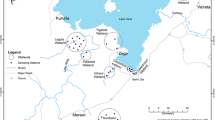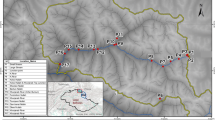Abstract
The aim of the study was to estimate the impact of mechanical deweeding on the community structure of phytophilous macroinvertebrates. The eutrophic lake selected for the study was Dal Lake in the Kashmir Himalayas. The dissolved nutrient concentration was found to be highest in August and September, i.e., nitrates-nitrogen (513 μg l−l) and total phosphorus (685 μg l−l). During the period of investigation, a total of 22 macroinvertebrate taxa were recorded which belonged to phylum Arthropoda, Mollusca, and Annelida. The samples were collected with the help of a composite Gerking frame box and grappler. Mechanical deweeding had a profound impact on the population density of phylum Mollusca and Arthropoda followed by Annelida. However, family Tubificidae was not influenced by deweeding, as the harvester only trimmed the vegetation, and these organisms were recorded in the sediment of the lake. On average, the reference site had higher density of macroinvertebrates as compared to deweeded areas. The abundance of macroinvertebrates decreased from 200 ind. (individuals) m−2 in the reference site to 51 ind. m−2 in the deweeded site as a result of weed removal. Species richness and composition of major macroinvertebrates in harvested and unharvested areas of the lake were also dissimilar as portrayed by biotic indices vis-à-vis Shannon diversity index, evenness index, and Simpson index.







Similar content being viewed by others
References
AHEC- Roorke (2000) Detailed project report for conservation and management of Dal lake. www.J&K Lakes and Waterways Development Authority.htm.
APHA (1998) Standard methods for the examination of water and wastewater, 20th edn. American Public Health Association, Washington, DC, p 1270
Balci P, Kennedy JH (2003) Comparison of chironomids and other macroinvertebrates associated with Myriophyllum spicatum and Heteranthera dubia. J Freshw Ecol 18(2):235–247
Balciunas J, Center T (1988) Australian insects to control hydrilla. pp. 323–319. In Herbivorous insect fauna of H. verticillata 311 Proceedings 22nd Annual Meeting Aquatic Plant Control Research Program, 16–19 November 1987, Portland, Oregon. Miscellaneous paper A-88-5. U.S. Army Corps of Engineers, Waterways Experiment Station, Vicksburg, Mississippi.
Bergey EA, Balling SF, Collins JN, Lamberti GA, Resh VH (1992) Bionomics of invertebrates within an extensive Potamogeton pectinatus bed of California marsh. Hydrobiol 243:15–24
Bogut I, Vidakovi J, Palijan G, Cerba D (2007) Benthic macroinvertebrates associated with four species of macrophytes. Biologia 62:600–606
Borror DJ, Delong DM, Triplehorn CA (1976) An introduction to the study of insects. 4th Edn., Holt Reinhert and Winston, New York, p 852
Bryan AD (1975) Experimental hydraulic dredging for aquatic weed control in Vernon Arm, Okanagan Lake Pt VIII. Water Investigations Branch. British Columbia MoEF, Victoria, 158
Buckingham GR, Bennett CA (1989) Laboratory host range of Parapoynx diminutalis (Lepidoptera: Pyralidae), an Asian aquatic moth adventives in Florida and Panama on Hydrilla verticillata (Hydrocharitaceae). Environ Entomol 18:526–530
Cattaneo A, Kalff J (1980) The relative contribution of aquatic macrophytes and their epiphytes to the production of macrophyte beds. Limnol Oceanogr 25:280–289
Edmondson WT (1959) Freshwater biology, 2nd edn. Wiley, New York, 45
ENEX (1978) Pollution of Dal lake. Enex of New Zealand Inc, 140 pp
Gerking SD (1957) A method of sampling the littoral macrofauna and its application. Ecology 38(2):219–226
Glime JM, Clemons RM (1972) Species diversity of stream insects on Frontinalis spp. compared to diversity on artificial substrates. Ecology 53:458
Goldson SL (1977) Larvae of four New Zealand species of Psychoda (Diptera: Psychodidae). N Z Entonzologist 6(3):279
Gregg WW, Ross FL (1985) Influences of aquatic macrophytes on invertebrate community structure, guild structure and micro-distribution in streams. Hydrobiol 128:45–46
Harrod JJ (1964) The distribution of invertebrate on submerged aquatic plant in a chalk stream. J Anim Ecol 33(2):335–348
Higler LWG (1975) Analysis of the macrofauna-community on Stratiotes vegetation. Verh Int Ver Theor Angew Limnol 19:2773–2777
Iversen TM, Thorup J, Hansen T, Lodal J, Olsen J (1985) Quantitative estimates and community structure of invertebrates in a macrophyte rich stream. Arch Hydrobiol 102:291–301
** X, Xu Q, Huang C (2005) Current status and future tendency of lake eutrophication in China. Sci China Ser C Life Sci 48(2):948–954
Jurberg P, Coelho-de-silva CLPA, Barreto MGM, Soares MS (1988) Rheotaxis of Biomphalaria glabrata on vertical substrates and its role in recolonization of habitat treated with molluscicides. Mem Inst Oswaldo Cruz Rio de Janeiro 83(2):165–174
Kaenel BR, Matthaei CD, Uehlinger U (1998) Disturbance by aquatic plant management in streams: effects on benthic invertebrates. Regulated River: Res Manag 14:341–356
Keast A (1984) The introduced aquatic macrophyte, Myriophyllum spicatum, as habitat for fish and their invertebrate prey. Can J Zool 62(7):1289–1303
Linhart J, Uvira V, Rulik M, Rulikova K (1998) A study of the composition of phytofauna in Batrachium aquatile vegetation. Acta Univ Palacki Olomuc Fac Rer Nat Biol 36:39–60
Lodge DM (1985) Macrophyte-gastropod associations: observations and experiments on macrophyte choice by gastropods. Freshw Biol 15:695–708
McCafferty WP, Provonsha AV (1998) Aquatic entomology. Jones and Bartlett, Toronto
Monahan C, Caffrey JM (1996) The effect of weed control practices on macroinvertebrate communities in Irish canals. Hydrobiologia 340:205–211
Nalepa TF, Hartson DJ, Fanslow DL, Lang GA, Lozano SJ (1998) Decline in benthic macroinvertebrate population in southern Lake Michigan. Can J Fish Aquat Sci 52:2402–2413
NLCP (National Lake Conservation Plan) (1997) Conservation and management of lakes: an Indian perspective (2010). MoEF, GoI
Pennak WR (1978) Fresh-water invertebrates of the United States. Wiley-Interscience, New York
Pielou EC (1966) Shannon’s formula as a measure of species diversity: its use and misuse. Am Nat 100:463–465
Poi de Neiff A, Carignan R (1997) Macroinvertebrates on Eichhornia crassipes roots in two lakes of the Paraná River floodplain. Hydrobiologia 345:185–196
Qadri H, Yousuf AR (2008) Dal Lake ecosystem: conservation strategies and problems. Proceedings of Taal 2007: The 12th World Lake Conference: 1453–1467.
Rosenberg DM, Resh VH (1993) Introduction to freshwater biomonitoring and benthic macroinvertebrates. In: Rosenberg DM, Resh VH (eds) Freshwater biomonitoring and benthic macro-invertebrates. Chapman and Hall, New York, pp 1–9
Shannon CE, Weaver W (1976) Mathematical theory of communication. University of Illinois, Urbana, p 117
Simpson EH (1949) Measurement of diversity. Nature 163:688
Soszka GJ (1975) Ecological relations between invertebrates and submerged macrophytes in the lake littoral. Ekol Pol 23:393–415
Takagi S, Kikuchiz E, Doi H, Shikonoz S (2005) Swimming behavior of Chironomus acerbiphilus larvae in Lake Katanuma. Hydrobiologia 548:153–165
Vadeboncoeur Y, Jeppesen E, Zanden MJV, Schierup H, Christoffersen K, Lodge DM (2003) From Greenland to green lakes: cultural eutrophication and the loss of benthic pathways in lakes. Limnol Oceanogr 48(4):1408–1418
Wetzel RG, Likens G (2000) Limnological analyses. Springer, New Delhi
Acknowledgments
The authors are highly thankful to Prof. A. R. Yousuf for his thoughtful insight and mentoring during the research work. The authors also wish to thank Prof. Azra N. Kamili for providing the necessary laboratory facilities.
Author information
Authors and Affiliations
Corresponding author
Additional information
Responsible editor: Philippe Garrigues
Rights and permissions
About this article
Cite this article
Habib, S., Yousuf, A.R. Impact of mechanical deweeding on the phytophilous macroinvertebrate community of an eutrophic lake. Environ Sci Pollut Res 21, 5653–5659 (2014). https://doi.org/10.1007/s11356-013-2470-7
Received:
Accepted:
Published:
Issue Date:
DOI: https://doi.org/10.1007/s11356-013-2470-7




